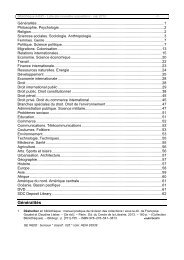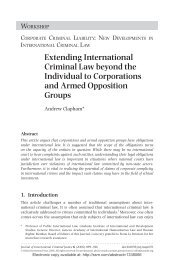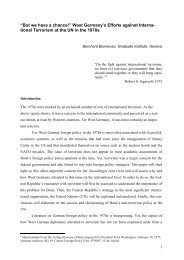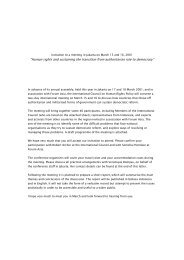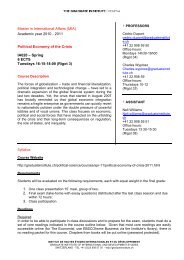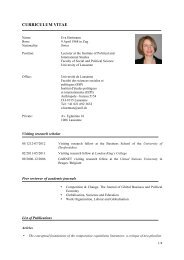Download - The Graduate Institute, Geneva
Download - The Graduate Institute, Geneva
Download - The Graduate Institute, Geneva
Create successful ePaper yourself
Turn your PDF publications into a flip-book with our unique Google optimized e-Paper software.
Expression of a necessary compromise between the value of human dignity and the<br />
State’s prerogative to remove persons from its jurisdiction, the test for the<br />
application of the principle highlights this compromise through its ambiguity: a<br />
person should not be returned if there are substantial grounds for believing that it<br />
would be in danger of being subjected to torture upon return. 22 <strong>The</strong> risk of torture<br />
should be real and/or foreseeable and a pattern of human rights violations and<br />
torture in the country of return strengthens the belief that substantial grounds exist,<br />
but does not suffice on its own for determining whether the principle is breached or<br />
not. In addition to this, the scrutiny standard requires governments to proceed to a<br />
speculative appreciation of the situation after return, while human rights bodies<br />
examining claims concerning the violation of the principle usually reach their verdict<br />
also on the basis of subsequent (to return) information. 23<br />
All these qualifications allow governments to shape the test by invoking<br />
different elements that should be taken into consideration. It is against this<br />
background that the practice of diplomatic assurances takes place and should be<br />
assessed. More precisely, diplomatic assurances aim at reducing the risk of torture<br />
below the threshold set by the principle of non-refoulement in countries where torture<br />
is an endemic phenomenon. <strong>The</strong>y form part of the factual evidence when examining<br />
the non-refoulement test. But while they have been presented as a way of complying<br />
with human rights obligations 24 , many international lawyers sharply criticise states<br />
for the use of assurances. Diplomatic assurances are considered insufficient<br />
safeguards against torture and states using them are accused of indirectly trying to<br />
free themselves of their legal obligations. Some circles even suggest that diplomatic<br />
22<br />
It should be noted that this phrase is a combination of the various standards of scrutiny applied in assessing<br />
the risk of torture and ill-treatment in refoulement cases; for more details, see Expert Workshop on Human Rights<br />
and International Co-operation in Counter-Terrorism, 15-17 November 2006, Final Report, OSCE Office for<br />
Democratic Institutions and Human Rights – Office of the Unites Nations High Commissioner for Human<br />
Rights, Doc. ODIHR.GAL/14/07, 21 February 2007, available at http://www.osce.org/documents/odihr/<br />
2007/02/23424_en.pdf, §16; see also Schimmel, Constanze Alexia, Returning Terrorist Suspects against<br />
Diplomatic Assurances: Effective Safeguard or Undermining the Absolute Ban on Torture and Other Cruel, Inhuman<br />
and Degrading Treatment?, available at http://www.nottingham.ac.uk/shared/shared_hrlcpub/Schimmel.pdf<br />
23<br />
See for example the Case of Mamtkulov and Askarov v. Turkey, ECtHR, Applications Nos. 46827/99 and<br />
46951/99, judgment of 4 February 2005, REPORTS OF JUDGMENTS AND DECISIONS 2005-I, §§67-68, where the<br />
ECtHR declared that “it will have to assess Turkey’s responsibility under Article 3 by reference to the situation<br />
that obtained on 27 March 1999 [day of extradition]” but then decided “in the light of the material before it”,<br />
which led some judges and some scholars to suggest that the Court placed reliance also on the medical reports<br />
from the doctors of the Uzbek prisons after the extradition had taken place; see Joint Partly Dissenting Opinion<br />
of Judges Sir Nicolas Bratza, Bonello and Hedigan, ibid, §§9 and 12 of the opinion. See also Walker, Clive, <strong>The</strong><br />
Treatment of Foreign Terror Suspects, 70 MODERN LAW REVIEW (2007), σ. 427-457, at 448. See also the CAT<br />
Comittee’s euphemism that “subsequent events are relevant to the assessment of the State party’s knowledge<br />
actual or constructive at the time of removal” (Brada v. France, Application No. 195/2002, decision of 17 May<br />
2005, UN Doc. CAT/C/34/D/195/2002 (2005)) after being accused of making an ex post fact assessment of the<br />
risk in previous cases.<br />
24<br />
See Jones, Kate, Deportations with Assurances: Addressing Key Criticisms, 57 ICLQ (2008), σ. 183-194, at 185.<br />
5



![Download [pdf] - The Graduate Institute, Geneva](https://img.yumpu.com/23370020/1/190x248/download-pdf-the-graduate-institute-geneva.jpg?quality=85)
